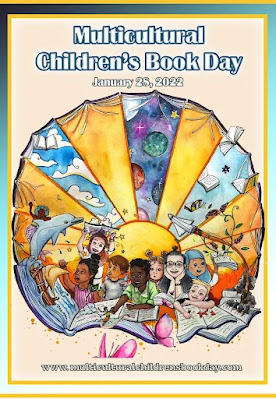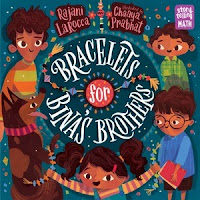This non-profit children’s literacy initiative was founded by Valarie Budayr and Mia Wenjen, two diverse book-loving moms who wanted to shine a spotlight on multicultural books and authors, and get those books into the hands of educators and young readers.
I'm privileged to be a MCBD book reviewer for the eighth year. I received four wonderful #ownvoices books to review today. Just look at these beautiful books! Let's get them (and lots of diverse books!) onto kids' bookshelves. Keep reading after the reviews for info about MCBD resources and programming -- and a Twitter party on Friday.
Written and illustrated by Australian artist Maxine Beneba Clarke, When We Say Black Lives Matter (Candlewick) is a poetic anthem complemented with powerful art. A Black child's parents explain the BLM movement with moving lines like:
Dinner on Domingos, written by Alexandra Katona and illustrated by Claudia Navarro (Barefoot Books) invites us to enjoy the Sunday traditions of an extended Ecuadorian-American family. All the tias, tios, and primos gather at abuelita's house for playing, dancing, remembering, and dining on yummy locro (potato soup) and other delicacies. Spanish words are used naturally, with context to signal their meanings. Lively prose and colorful illustrations show how each room in abuelita's home has a special purpose and meaning, and how together they help turn Sunday into "Domingo, the best day of the week." Katona's author's note adds depth and detail and includes photos of the author and her abuelita, along with a recipe for locro. Yum!

 The Kayla: A Modern Day Princess picture book series is created by Make A Way Media (Super Platinum MCBD sponsor), written by Deedee Cummings and illustrated by Charlene Mosley. Inspired by the life of Cummings' own daughter, actress Kayla Pecchioni, these books follow the story of a Black girl who dreams of singing and dancing on Broadway. I was able to review the final book in the series, "A Little Magic," in which Kayla finishes college and is ready to fly. Kayla explains to her mom that rather than getting married, she's heading off to follow her Broadway dreams. In this sweet tale, Mom is surprised but ultimately supportive. Mother and daughter reflect on the lessons and milestones from her childhood that have enabled Kayla to make her own plan for her life, and then to follow it. An inspirational read for all.
The Kayla: A Modern Day Princess picture book series is created by Make A Way Media (Super Platinum MCBD sponsor), written by Deedee Cummings and illustrated by Charlene Mosley. Inspired by the life of Cummings' own daughter, actress Kayla Pecchioni, these books follow the story of a Black girl who dreams of singing and dancing on Broadway. I was able to review the final book in the series, "A Little Magic," in which Kayla finishes college and is ready to fly. Kayla explains to her mom that rather than getting married, she's heading off to follow her Broadway dreams. In this sweet tale, Mom is surprised but ultimately supportive. Mother and daughter reflect on the lessons and milestones from her childhood that have enabled Kayla to make her own plan for her life, and then to follow it. An inspirational read for all.SUPER PLATINUM: Make A Way Media
PLATINUM: Language Lizard
GOLD: Barefoot Books, KidLitTV, Candlewick, Capstone, Abrams Books
SILVER: Pack-n-Go Girls, Charlotte Riggle, Kimberly Gordon Biddle
BRONZE: Carole P. Roman, Patrice McLaurin, Dyesha and Triesha McCants/McCants Squared, Redfin.com, Redfin Canada, Redfin Mortgage, Redfin/Title Forward, Create & Educate, Star Bright Books, Vivian Kirkfield, Dr. Eleanor Wint, Kind World Publishing, Snowflake Stories, Lisa Wee, SONGJU MA, Melissa Stoller, J.C. Kato and J.C.², Crystel Patterson, Audrey Press, Pragmaticmom, TimTimTom, Wisdom Tales
MCBD 2022 is Supported by these Author Sponsors:
Charlene Mosley (official MCBD2022 Poster Creator)
Illustrator Isabelle Roxas (Class Kit Poster Creator)
Alva Sachs, Brianna Carter, Ebony Zay Zay, Rita Bhandari, Gwen Jackson, Lois Petren/The 5 Enchanted Mermaids, Valerie Williams-Sanchez and Valorena Publishing, Josh Funk, Afsaneh Moradian, Eugenia Chu, Maritza Martínez Mejía, Diana Huang, Kathleen Burkinshaw, CultureGroove, Sandra Elaine Scott, Dorena Williamson, Veronica Appleton, Alejandra Domenzain, Lauren Muskovitz and Sandfish Publishing, Tonya Duncan Ellis, Kimberly Lee, Susan Schaefer Bernardo & Illustrator Courtenay Fletcher, Nancy Tupper Ling, Winsome Hudson-Bingham, Amanda Hsiung-Blodgett, Sivan Hong, Michael Genhart, Debbie Dadey, Elizabeth Cureton, Stephanie Wildman, Maryann Jacob, Sherri Maret, Rochelle Melander, Dia Mixon, Kiyanda and Benjamin Young, Shereen Rahming, Linda Thornburg and Katherine Archer, Rebecca Flansburg and BA Norrgard , Maxine Schur Natalie McDonald-Perkins
MCBD 2022 is Honored to be Supported by our CoHosts and Global CoHosts!
MCBD 2022 is Honored to be Supported by these Media Partners!
Check out MCBD's Multicultural Books for Kids Pinterest Board!
FREE RESOURCES from Multicultural Children’s Book Day
Diversity Book Lists & Activities for Teachers and Parents
Homeschool Diverse Kidlit Booklist & Activity Kit
FREE Teacher Classroom Activism and Activists Kit
FREE Teacher Classroom Empathy Kit
FREE Teacher Classroom Kindness Kit
FREE Teacher Classroom Physical and Developmental Challenges Kit
FREE Teacher Classroom Poverty Kit
FREE Homeschool Diverse Kidlit Booklist & Activity Kit
FREE Teacher Classroom Raising Awareness on Systemic Racism in America Classroom Kit
FREE Diversity Book for Classrooms Program
Join the MCBD celebration on Friday, Jan 28, 2022, at 9 pm EST for the 9th annual Multicultural Children's Book Day Twitter Party!
This epically fun and fast-paced hour includes multicultural book discussions, addressing timely issues, diverse book recommendations, & reading ideas. MCBD will be giving away an 8-Book Bundle every 5 minutes plus Bonus Prizes as well! *** US and Global participants welcome. ***
Follow the hashtag #ReadYourWorld to join the conversation and connect with like-minded parents, authors, publishers, educators, organizations, and librarians. And, follow MCBD and Make A Way Media on Twitter. And don't forget that Twitter party!

















